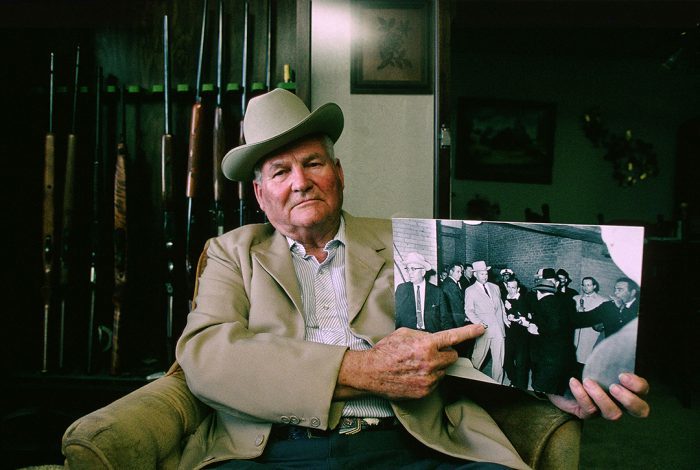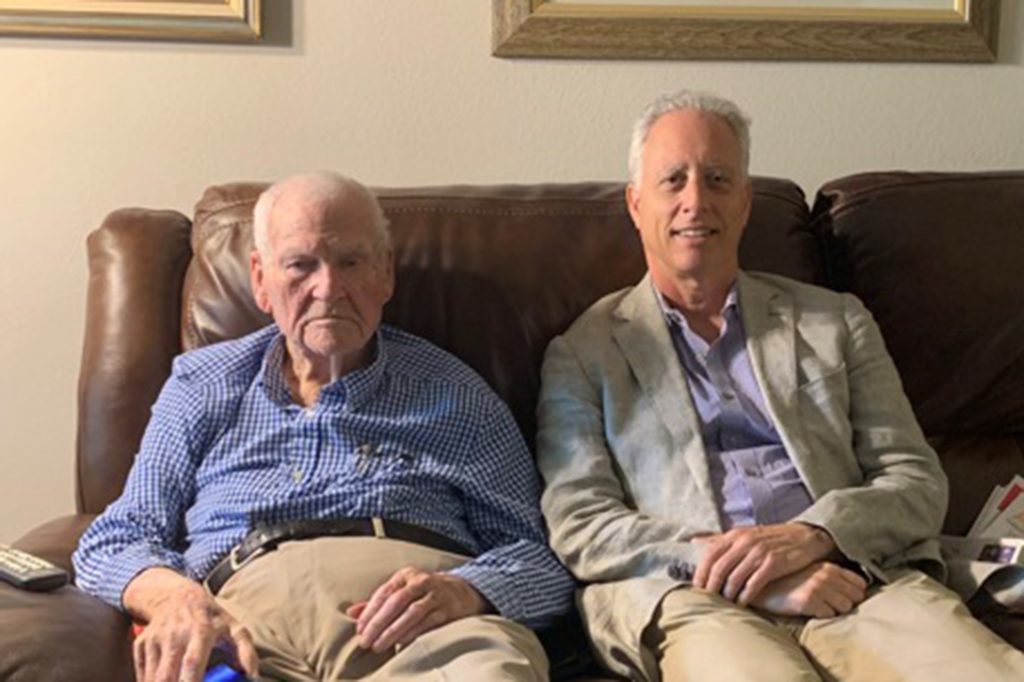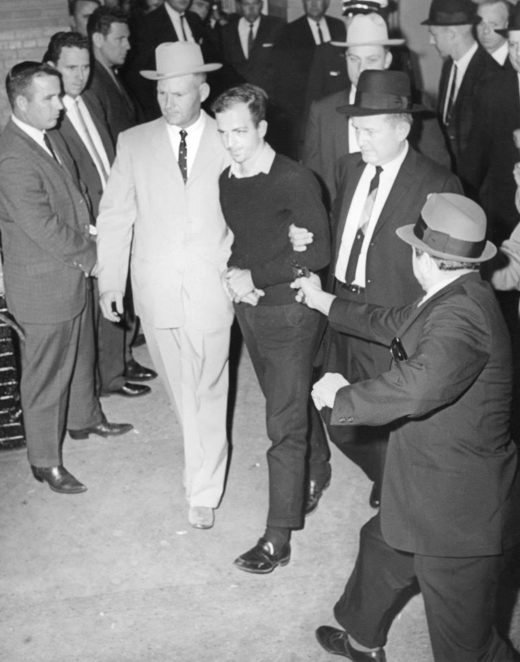
Denne fredag var det have været 56 årsdagen for drabet på John F. Kennedy, som det påstås blev udført af Oswald. Søndag er det 56 årsdagen for Rubys drab på Oswald i garagen hos Dallas' Politiafdeling.
En slående påstand fra den pensionerede detektiv James Leavell, ved Dallas Politi, næsten i forbifarten, var at han tog noter, da han forhørte Oswald.
Dette strider mod den officielle position, fra politiafdelingen at ingen optegnelser eller optagelser eksisterer.
Kommentar: Delvist oversat af Sott.net fra JFK Assassination Anniversary: Oswald Murder Witness Speaks
In 1964, at a time when witnesses reported coming under heavy pressure to conform to an emerging consensus narrative that Oswald had acted alone, Leavelle testified to the Warren Commission that he had not taken notes. In his recent conversation with WhoWhatWhy, however, he insisted he had, and he also said that others took notes during a formal department interrogation of Oswald.
In addition, Leavelle talked of having a years-long relationship with Ruby — prior to Ruby shooting Oswald, with Leavelle inches away in a now-famous white Stetson and tan outfit. He also reiterated his firm belief that both Oswald and Ruby were lone gunmen, with no ties to each other or any other conspirators.
In an interview in June at his home in a Dallas suburb, Leavelle spoke for nearly two hours with me and a research assistant, Brian Baccus.
Leavelle shared details of his entire life, including the events of November 22, 1963. Although elderly — he was 98 years old at the time of the interview — he showed lucidity and good recall. In fact, after our interview, he turned 99 and visited relatives in another state; at that point he fell and broke his hip — he died soon after.
Leavelle, who enlisted in the Navy after graduating from high school, was on a ship a couple of miles from Pearl Harbor when Japanese planes attacked the base. After the war, he worked as an auditor for the Veterans Administration, and in 1950 joined the Dallas Police Department.

"They put out an order that all those places would close at midnight," Leavelle said. "I went in and talked to him and got to know him pretty well. He promised to shut at midnight, and he kept his word."
Significantly, Leavelle said that Ruby — who two years after his arrest would claim that a conspiracy surrounded Oswald's, and perhaps Kennedy's, death — was reliable.
"He was the best I had," Leavelle said, comparing Ruby to the myriad proprietors on his beat. "I don't think he ever lied to me."
Relationships between law enforcement and those on the seamier side of the track were notably informal in those days.
On one occasion, Leavelle said, he went into the club to talk to two dancers who were in some sort of dispute with Ruby. "They were complaining about him, and I was given the job to talk to him. I went down there and they were not performing and I said I needed to talk to them, but they had to get ready. We went into the back where performers changed clothes, [and one] undressed while I asked questions. I wrote it up, then spoke to the other woman."
Ruby was close not only to Leavelle but also to the Dallas Police Department in general. This is one of many tantalizing aspects of the Kennedy assassination scenario which, although well known to JFK assassination researchers, got short shrift from official inquiries and traditional media, textbook, and other establishment accounts that have been widely disseminated.
Ruby's Carousel Club served as a frequent hangout for many Dallas cops; some, when off duty, even worked there as security guards. This has led to informed speculation that many officers in the Dallas Police Department had been aware of Ruby's alleged underworld links and were possibly compromised by them.
Intriguingly, Ruby was said to have been the Chicago mob's payoff man for the Dallas Police Department. The nightclub operator underlined that closeness when he was apprehended for shooting Oswald, protesting to the officers closing in on him: "You all know me. I'm Jack Ruby!"
When Luis Kutner, an attorney for Ruby, met with the staff of a congressional committee on organized crime in 1950, he said that "Ruby was a syndicate lieutenant who had been sent to Dallas to serve as a liaison for Chicago mobsters."
This claim, in an article by the prominent journalist Milton Viorst, is in stark contrast to a constant refrain presented to the public, from the Warren Commission to modern news reports, that Ruby was simply an erratic nightclub owner — just as Oswald's documented history of intelligence connections has been obscured.
Ruby, like many figures in the saga — some of whom have described pressure and even threats from authorities and others — couldn't keep his story straight. He provided contradictory explanations at varying times about why he killed Oswald. After claiming he'd wanted to be a hero — which is what he told Leavelle and others at the time — or that he'd wanted to spare Jackie Kennedy the agony of a trial, Ruby would later say that a conspiracy at the highest levels was afoot and that these individuals manipulated Ruby to be the designated killer of Oswald.
Ruby's claims of a conspiracy have been discounted because of his declining mental health toward the end of his life. But an explanation for some of his odd behavior may lie with one of the psychiatrists who examined him in prison.
Louis Jolyon West, a well-known expert on brainwashing, spent much of his career as chair of the psychiatry departments at the University of Oklahoma and then UCLA. He was among the doctors and scientists who contracted with the CIA to perform experiments for its MK-ULTRA mind control program. A particular focus of West's research was inducing dissociative states in his subjects; this included the use of both drugs and hypnosis.
Critics of West and his active role in these experiments note that Jack Ruby experienced a "psychotic break" immediately after West analyzed him in April of 1964.
Comment: But not before Ruby told his defense lawyer William Kunstler that he had killed Oswald "for the Jews." Ruby's rabbi Hillel Silverman received the same confession when visiting Ruby in jail.
The Oswald Club
Leavelle also revealed that a small group of people from the Dallas police department — many of whom were on duty on November 22 — stayed in frequent touch with him and that some would meet over the course of many years every Wednesday at Leavelle's house and go to lunch and recount events.
This group included several other former DPD officers, plus Marie Tippit, the widow of Officer J.D. Tippit — whose shooting shortly after Kennedy's was pinned on Oswald, and used as proof of Oswald's capacity for violence (which was never proven with regard to the shooting of Kennedy himself). Leavelle was actually in charge of the investigation into Tippit's murder. The group also included the motorcycle cops who participated in Kennedy's motorcade. Many have died in recent years.
Although the murder of J.D. Tippit has been blamed on Oswald, several witnesses to the shooting raised serious doubts as to whether Oswald was involved. Thus, the certitude professed by the unified lunch group as to Oswald's guilt stands in stark contrast to the mounting doubts of others over who actually killed Tippit.
Efforts to proffer Tippit's widow as a focal point of public fury directed at — and implicitly blaming — Oswald began in the immediate aftermath of November 22. At that time, Eugene M. Locke — of the prominent Dallas law firm Locke, Purnell, Boren, Laney & Neely — stepped forward to provide the widow with advice.
A former president of TIPRO — a Texas oil and gas advocacy group — Locke was connected at the highest levels of Texas politics, and very close to Lyndon Johnson, who became president after Kennedy's death. Locke had run the successful gubernatorial campaign of LBJ protégé John Connally in 1962, then served as chairman of the State Democratic Executive Committee of Texas.
A fateful meeting concerning the motorcade route for Kennedy's trip to Dallas was held in Locke's office on November 14, 1963. Johnson would later name Locke ambassador to Pakistan and then deputy ambassador to South Vietnam.
The continuing JFK police officer luncheon group was organized by a younger retired officer, Rick Janich, who has been working for years to create a Dallas Police Museum in hopes of rehabilitating the image of the department, which has been under a cloud ever since the tragic events. All of the luncheon group members insisted that no conspiracy was involved in Kennedy's death, and that Oswald was the sole gunman. The net effect was to create a circle of "true believers" whose meetups would reinforce each other's beliefs.
Janich, Leavelle, and others in this circle did not appear to closely follow investigative developments or the vast body of research that has been done in the ensuing years.
"I don't read the books," Janich said over lunch. "Jim and Marie are the books." Nonetheless, Janich has been involved in public discussions of the assasination, including a Military Channel special, Capturing Oswald, which was written and developed by Leavelle's granddaughter; Janich is listed in the credits.
Leavelle's claim that he took notes on his own interrogation of Oswald — and turned them in — is quite confounding, since the authorities have insisted that no notes or recordings of Oswald being questioned ever existed. Detectives Captain Will Fritz, Leavelle's boss, dictated some notes from memory several days after the assassination. However, US Postal Inspector Harry Holmes, who was present during Oswald's interrogation Sunday morning, recorded the following comment made by Oswald when Fritz asked the former Marine about an ID card with the name A.J. Hidell: "I've told you all I'm going to about that card. You took notes, just read them for yourself, if you want to refresh your memory."
FBI agent James P. Hosty, who was present at the department's interrogation of Oswald on November 22, did supposedly write down what he heard and then prepared a formal report based on those notes. He told the Warren Commission that he destroyed them, as was customary for FBI agents once the notes are used for a formal report.
However, many years later, Hosty claimed to have discovered that he actually did not destroy the notes. He produced pictures of them in his book, Assignment Oswald, and they were turned over to a 1990s investigative panel, the Assassination Records Review Board. In addition, he disputed Oswald's claim that Fritz had taken pen in hand:
"While I had been furiously scribbling on what Oswald was reporting, I had noticed that I was the only one doing so. But then, that would be what I'd expect. Captain Fritz was an experienced homicide interrogator. The fact that he wasn't taking notes was standard operating procedure. Fritz was conducting his first run-through with Oswald, and the object was to keep a suspect talking. Note-taking by an interrogator can be inhibiting. I was enough in the background during the interrogation so that note-taking seemed appropriate to me."Oswald famously denied that he was the shooter, saying that he had been framed as a "patsy." This adamant denial has always stood out to skeptics because of the many high-profile killers motivated by a desire for notoriety. In fact, a frequently cited study on high-profile assassinations, including political ones — the Secret Service Exception Case Study Project — found a primary motive to be that assassins felt invisible and wanted to be known.
Oswald's detailed accounting of his actions and movements are of course central to this spectacular case of the murder of the president. So Leavelle's revelation that contemporaneous notes existed — and still likely exist somewhere in police records — is of more than mere historical interest:
Baker: Why didn't they take any notes when they had Oswald in there?WhoWhatWhy reached out to City Archivist John H. Slate of the Dallas Municipal Archives, where all of the Dallas Police Department's records on the assassination have been stored since 1989. Slate said that he was not aware of any notes Leavelle may have written down during Oswald's interrogations.
Leavelle: What made you think we didn't?
Baker: Did you take any notes?
Leavelle: I did. I had some. Yeah.
Baker: And what happened to the notes?
Leavelle: They're probably still in the area down there somewhere.
Thus, this perplexing matter of what Lee Harvey Oswald said to substantiate his claim of having not shot Kennedy remains unresolved.
About That Suit and Hat
In the interview, WhoWhatWhy asked Leavelle why he chose to wear a tan suit and cowboy hat while escorting Oswald at the time of the shooting. The suit, along with somewhat garish orange-ish shoes, dramatically contrasts him from Oswald in now-iconic photos of the lawman and the suspect chained together as Ruby fires away.
Leavelle is quoted in an interview with the Dallas Morning News in 2002 as saying that he had been given the suit by a friend whom it no longer fit, and told us the same, adding that he wore it because he had nothing else to wear.
Why would anyone consider this important? Many believe the hit on Oswald was arranged, to prevent him from talking about others that might have been involved in the assassination. Given Ruby's close relationship with Leavelle and the cops, if indeed the silencing of Oswald was planned, then presumably measures were taken to reduce the risk to Leavelle.
About WhoWhatWhy
Where else do you see journalism of this quality and value?
Please help us do more. Make a tax-deductible contribution now.




Læserkommentarer
dig vores Nyhedsbrev